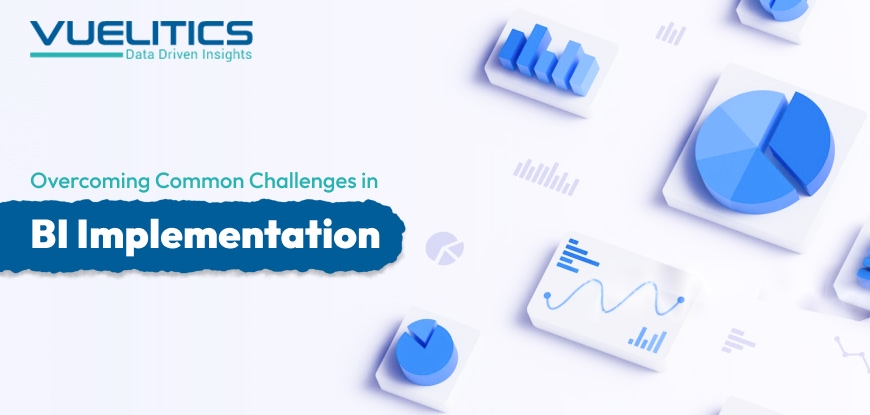- Home
- Blogs

Overcoming Common Challenges In BI Implementation
In the era of data, Business Intelligence (BI) is a foundation of success for an organization. However, some companies run into barriers when attempting to convert raw data into actionable insights. From issues with data integration to difficulties with user adoption, successful BI deployment depends on a lot more than simply getting the right tools in place, you need strategy, governance and project management.
This post discusses common BI challenges to be aware of for long-term success and gives actionable tips on how to overcome them so businesses can focus their time on monitoring their KPIs rather than being bogged down by analytics.
Understanding the Core BI Implementation Challenges
There’s little in the way of agreed-upon BI best practices to serve as a standard for Business Intelligence implementation. Too many businesses ‘dumb down’ their BI projects and do not integrate them with their strategy. Let’s take a look at some of the common business intelligence problems encountered in implementation:
Challenges with Data Integration: Businesses often find it difficult to harmonize data from different sources. With legacy systems, irregular formats or isolated databases, the integration of data is a complex and lengthy process.
Data Quality and Governance:
Any BI project is only as good as the underlying data on which it is based. Outdated, inconsistent or incomplete information results in false reports and incorrect business decisions.
User adoption in BI:
Even the most powerful BI system is useless unless your users stump up excitement. Employees may resist change, prefer traditional tools, or find the BI interface too complex.
BI Project Management:
Unclear projects, unrealistic timelines and a lack of stakeholder communication can turn BI projects towards failure.
Change Management in BI Projects:
A move to a new BI system takes a change in culture. Without effective change management, users don’t adopt new processes.
BI Performance Tuning:
After successful deployment, performance challenges like sluggish dashboards or late data refresh might hamper the effectiveness of your BI solution.
Risks of Business Intelligence Implementation
A BI project always carries a risk to your business intelligence system, which can lead to lower ROI and not-so-raining results of the project:
- Over-investing in Tools—In some cases, companies are investing very heavily in BI tools without necessarily having a use case or strategy.
- Not enough expertise: There are no BI analysts or data engineers who can handle these complex systems.
- Poor alignment of goals: BI systems that do not pursue business objectives can’t deliver actionable insights.
- Security and Compliance Risks: Poor governance may result in sensitive business data being compromised by security threats.
- Knowing these business intelligence risks is very important to address early on in the project life cycle.
BI Implementation Best Practices To Overcome Challenges
A rigorous and organized approach that is data-driven will be required for companies to succeed in implementing BI, both technically and institutionally. Below are the best practices for BI implementation that have been tried and tested to help overcome some of the hurdles:
Plan Your BI Initiative Clearly from the Start
Define your business intelligence strategy before you roll out any tools. Discover goals, KPIs, and success metrics for the business. A well-defined BI implementation roadmap ensures that tech systems are in sync to fulfill business needs.
Data Governance and Quality should be strong.
Invest in good data governance protocols for the collection, storage and use of data. Define validation rules, audit frequently, and establish accountability of data ownership.
Simplify Data Integration
Leverage advanced ETL (Extract, Transform, Load) software or data integration systems to bring together all forms of data sources. A data warehousing situation could be effortlessly managed by cloud-based solutions such as Snowflake, Azure Synapse, or AWS Redshift, which could also lessen the challenges related to data integration.
Establish User
Uptake through Training and Communication Hustling people or directly injecting high technology into employees and staff people to smoothly integrate them into the business.
To address such BI adoption obstacles, companies need to get end users involved early. Provide training in the form of demonstration, deliver value proposition, and gain feedback to enhance usability. Self-service BI tools help employees make data-driven decisions.
Performance Optimization Focus
It is enable to deploy business intelligence tools that are scalable and performant. Monitoring dashboard performance, query speed, and system load should always be on your radar. BI performance optimization can be greatly increased by proper use of caching and good data modeling.
Strengthen BI Project Management
Cross-functional cooperation is often necessary to manage a successful BI project. Assign BI champions, chunk objectives down and manage this evolutionarily by using agile methods.
Manage Change Effectively
It is important for BI projects to have change management. Communicate the why behind adopting BI, recognize quick wins and be perpetually supportive. Change agents are critical for smoothing the pathway to a data-oriented culture.
Constructing an Evergreen BI Plan and Approach
The best chance of long-term BI success lies in a flexible, level approach to business intelligence. Make your business intelligence configuration able to adjust to changes later on by putting in place these exercises:
- Develop your product step-by-step: Always keep your very first version extremely simple, verify the results and slowly broaden your work.
- Put your money into the cloud and AI: Trendy business intelligence (BI) systems incorporate AI and predictive analytics and are automate to provide more intelligent insights.
Improve the collaboration of different departments: Connect BI activities with marketing, finance, operations and HR goals to be able to get the highest business value. - Never stop measuring the effectiveness of BI: Implement feedback loops and carry out performance audits to ensure that your BI solutions evolve with the company.
Conclusion
Implementing business intelligence is not a one-and-done activity—it’s a constant process of fine-tuning, learning, and innovating. Agile BI is an ideal where developers develop and users use as they find issues. However, with the problems of data Quality, Integration and User adoption this all grinds to a halt, but like so many things in life, that can be countered by doing it right in the first place.
Through data governance, user participation and strategic project management techniques, companies can mitigate business intelligence issues and realize the full potential of their BI systems. armed with a roadmap to guide them throughout and a dedication to continually optimize, companies can transform data into decisions and sustain success.
FAQ: How to deal with the challenges of BI implementation
What are the biggest hurdles in the implementation of BI?
Typical business intelligence (BI) issues encountered during implementation are problems with data integration, low-quality data, user resistance, insufficient data management, and poor project management. These factors are usually to blame for the slow implementation process and the limited use of BI systems.
What can businesses do to solve data integration issues in BI?
When data integration is an issue, the organization should use powerful ETL tools, data warehouses, and integration platforms that integrate multiple data sources. Already here, we can decide to standardize data formats and automate data pipelines to maintain uniformity and confidence in our systems.
What are the major risk factors in implementing business intelligence?
Business intelligence risks are strategic and operational business inconsistencies with goals, data security weaknesses, unsuitable tool over investment, and deficiencies in the skills of BI professionals. Proactive planning and policy instruments can help reduce the likelihood of these risks.
What makes user adoption such a struggle for BI projects?
User adoption in BI can be difficult because employees may resist new tools or find them complex. Providing adequate training, simplifying dashboards, and involving end-users early in the BI design process can improve engagement and adoption rates.



Post Comments